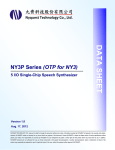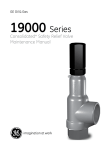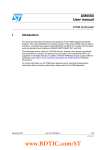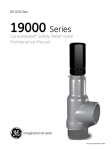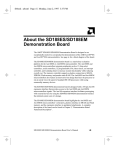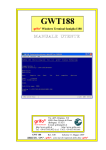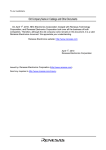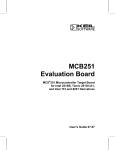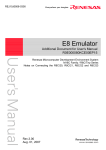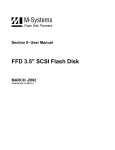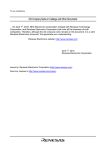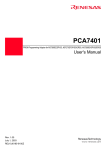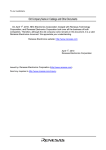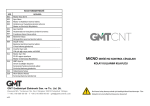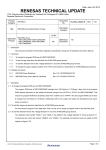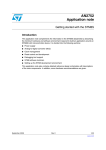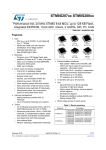Download STM8S bootloader user manual
Transcript
UM0560 User manual STM8S bootloader user manual 1 Introduction This user manual contains the bootloader specifications for STM8S devices which contain a bootloader embedded in the system memory of the device (the ROM memory). Through this firmware, the device memory can be erased and programmed using one of the standard communication interfaces present on the particular device. For each device, please refer to the corresponding datasheets to know if the bootloader is present and which peripherals are supported. The document describes the features and operation of the STM8S integrated bootloader program. This code allows memories, including Flash program, data EEPROM, and RAM, to be written into the device using the standard serial interfaces UART1, UART2, UART3, CAN, and SPI (only available on STM8S105xx devices). The bootloader code is the same for all STM8S versions, including STM8S20xxx and STM8S105xx devices. However, even though a peripheral may be present in a product, the product may not support it (for example, the SPI is not supported in STM8S20xxx devices). In addition, different cuts support different peripherals: The bootloader code can be accessed via the UART1, UART3 and CAN peripherals in STM8S20xxx devices and via UART2 and SPI in STM8S105xx devices. For further information on the STM8S family features, pinout, electrical characteristics, mechanical data and ordering information, please refer to the STM8S datasheets. December 2008 Rev 1 1/58 www.st.com Contents UM0560 Contents 1 Introduction . . . . . . . . . . . . . . . . . . . . . . . . . . . . . . . . . . . . . . . . . . . . . . . . 1 2 Bootloader introduction . . . . . . . . . . . . . . . . . . . . . . . . . . . . . . . . . . . . . . 6 2.1 3 4 Bootloader activation . . . . . . . . . . . . . . . . . . . . . . . . . . . . . . . . . . . . . . . . . 6 Peripheral settings . . . . . . . . . . . . . . . . . . . . . . . . . . . . . . . . . . . . . . . . . 10 3.1 UART1 settings . . . . . . . . . . . . . . . . . . . . . . . . . . . . . . . . . . . . . . . . . . . . 10 3.2 UART2 and UART3 settings . . . . . . . . . . . . . . . . . . . . . . . . . . . . . . . . . . . 10 3.3 SPI settings . . . . . . . . . . . . . . . . . . . . . . . . . . . . . . . . . . . . . . . . . . . . . . . 11 3.4 CAN settings . . . . . . . . . . . . . . . . . . . . . . . . . . . . . . . . . . . . . . . . . . . . . . 11 Bootloader command set . . . . . . . . . . . . . . . . . . . . . . . . . . . . . . . . . . . . 13 4.1 4.2 4.3 4.4 4.5 Get command . . . . . . . . . . . . . . . . . . . . . . . . . . . . . . . . . . . . . . . . . . . . . . 14 4.1.1 Get command via UART1/ UART2/UART3 . . . . . . . . . . . . . . . . . . . . . . 14 4.1.2 Get command via SPI . . . . . . . . . . . . . . . . . . . . . . . . . . . . . . . . . . . . . . 16 4.1.3 Get command via CAN . . . . . . . . . . . . . . . . . . . . . . . . . . . . . . . . . . . . . 18 Read memory command . . . . . . . . . . . . . . . . . . . . . . . . . . . . . . . . . . . . . 20 4.2.1 Read memory command via UART1/UART2/UART3 . . . . . . . . . . . . . . 20 4.2.2 Read memory command via SPI . . . . . . . . . . . . . . . . . . . . . . . . . . . . . . 22 4.2.3 Read memory command via CAN . . . . . . . . . . . . . . . . . . . . . . . . . . . . . 25 Erase memory command . . . . . . . . . . . . . . . . . . . . . . . . . . . . . . . . . . . . . 26 4.3.1 Erase memory command via UART1/UART2/UART3 . . . . . . . . . . . . . . 27 4.3.2 Erase memory command via SPI . . . . . . . . . . . . . . . . . . . . . . . . . . . . . 30 4.3.3 Erase memory command via CAN . . . . . . . . . . . . . . . . . . . . . . . . . . . . 32 Write memory command . . . . . . . . . . . . . . . . . . . . . . . . . . . . . . . . . . . . . 34 4.4.1 Write memory command via UART1/UART2/UART3 . . . . . . . . . . . . . . 34 4.4.2 Write memory command via SPI . . . . . . . . . . . . . . . . . . . . . . . . . . . . . . 37 4.4.3 Write memory command via CAN . . . . . . . . . . . . . . . . . . . . . . . . . . . . . 40 Speed command . . . . . . . . . . . . . . . . . . . . . . . . . . . . . . . . . . . . . . . . . . . 43 4.5.1 4.6 2/58 Speed command via CAN . . . . . . . . . . . . . . . . . . . . . . . . . . . . . . . . . . . 43 Go command . . . . . . . . . . . . . . . . . . . . . . . . . . . . . . . . . . . . . . . . . . . . . . 45 4.6.1 Go command via UART1/UART2/UART3 . . . . . . . . . . . . . . . . . . . . . . . 45 4.6.2 Go command via SPI . . . . . . . . . . . . . . . . . . . . . . . . . . . . . . . . . . . . . . . 47 UM0560 Contents 4.6.3 4.7 Go command via CAN . . . . . . . . . . . . . . . . . . . . . . . . . . . . . . . . . . . . . . 49 Sector codes . . . . . . . . . . . . . . . . . . . . . . . . . . . . . . . . . . . . . . . . . . . . . . 50 5 Software model . . . . . . . . . . . . . . . . . . . . . . . . . . . . . . . . . . . . . . . . . . . . 54 6 Error management . . . . . . . . . . . . . . . . . . . . . . . . . . . . . . . . . . . . . . . . . 55 7 Programming time . . . . . . . . . . . . . . . . . . . . . . . . . . . . . . . . . . . . . . . . . . 56 8 Revision history . . . . . . . . . . . . . . . . . . . . . . . . . . . . . . . . . . . . . . . . . . . 57 3/58 List of tables UM0560 List of tables Table 1. Table 2. Table 3. Table 4. Table 5. Table 6. Table 7. Table 8. Table 9. Table 10. 4/58 Initial checking . . . . . . . . . . . . . . . . . . . . . . . . . . . . . . . . . . . . . . . . . . . . . . . . . . . . . . . . . . . 9 Serial interfaces associated with STM8S devices . . . . . . . . . . . . . . . . . . . . . . . . . . . . . . . 10 Bootloader commands . . . . . . . . . . . . . . . . . . . . . . . . . . . . . . . . . . . . . . . . . . . . . . . . . . . . 13 Examples of delay . . . . . . . . . . . . . . . . . . . . . . . . . . . . . . . . . . . . . . . . . . . . . . . . . . . . . . . 38 STM8S sector codes . . . . . . . . . . . . . . . . . . . . . . . . . . . . . . . . . . . . . . . . . . . . . . . . . . . . . 50 Error table . . . . . . . . . . . . . . . . . . . . . . . . . . . . . . . . . . . . . . . . . . . . . . . . . . . . . . . . . . . . . . 55 UART1/UART2/UART3 programming times. . . . . . . . . . . . . . . . . . . . . . . . . . . . . . . . . . . . 56 SPI programming time . . . . . . . . . . . . . . . . . . . . . . . . . . . . . . . . . . . . . . . . . . . . . . . . . . . . 56 CAN programming time . . . . . . . . . . . . . . . . . . . . . . . . . . . . . . . . . . . . . . . . . . . . . . . . . . . 56 Document revision history . . . . . . . . . . . . . . . . . . . . . . . . . . . . . . . . . . . . . . . . . . . . . . . . . 57 UM0560 List of figures List of figures Figure 1. Figure 2. Figure 3. Figure 4. Figure 5. Figure 6. Figure 7. Figure 8. Figure 9. Figure 10. Figure 11. Figure 12. Figure 13. Figure 14. Figure 15. Figure 16. Figure 17. Figure 18. Figure 19. Figure 20. Figure 21. Figure 22. Figure 23. Figure 24. Figure 25. Figure 26. Figure 27. Figure 28. Figure 29. Figure 30. Figure 31. Figure 32. Figure 33. Figure 34. Bootloader activation flow chart . . . . . . . . . . . . . . . . . . . . . . . . . . . . . . . . . . . . . . . . . . . . . . 7 CAN frame . . . . . . . . . . . . . . . . . . . . . . . . . . . . . . . . . . . . . . . . . . . . . . . . . . . . . . . . . . . . . 11 Get command via UART1/UART2/UART3 Host side . . . . . . . . . . . . . . . . . . . . . . . . . . . . . 14 Get command via UART1/UART2/UART3: Device side. . . . . . . . . . . . . . . . . . . . . . . . . . . 15 Get command via SPI: Host side . . . . . . . . . . . . . . . . . . . . . . . . . . . . . . . . . . . . . . . . . . . . 16 Get command via SPI: Device side . . . . . . . . . . . . . . . . . . . . . . . . . . . . . . . . . . . . . . . . . . 17 Get command via CAN: Host side . . . . . . . . . . . . . . . . . . . . . . . . . . . . . . . . . . . . . . . . . . . 18 Get command via CAN: Device side . . . . . . . . . . . . . . . . . . . . . . . . . . . . . . . . . . . . . . . . . 19 Read memory command via UART1/UART2/UART3: Host side . . . . . . . . . . . . . . . . . . . . 20 Read memory command via UART1/UART2/UART3: Device side . . . . . . . . . . . . . . . . . . 21 Read memory command via SPI: Host side . . . . . . . . . . . . . . . . . . . . . . . . . . . . . . . . . . . . 22 Read memory command via SPI: Device side . . . . . . . . . . . . . . . . . . . . . . . . . . . . . . . . . . 24 Read memory command via CAN: Host side . . . . . . . . . . . . . . . . . . . . . . . . . . . . . . . . . . . 25 Read memory command via CAN: Device side . . . . . . . . . . . . . . . . . . . . . . . . . . . . . . . . . 25 Erase memory command via UART1/UART2/UART3: Host side. . . . . . . . . . . . . . . . . . . . 27 Erase memory command via UART1/UART2/UART3: Device side . . . . . . . . . . . . . . . . . . 29 Erase memory command via SPI: Host side . . . . . . . . . . . . . . . . . . . . . . . . . . . . . . . . . . . 30 Erase memory command via SPI: Device side. . . . . . . . . . . . . . . . . . . . . . . . . . . . . . . . . . 31 Erase memory command via CAN: Host side. . . . . . . . . . . . . . . . . . . . . . . . . . . . . . . . . . . 32 Erase memory command via CAN: Device side . . . . . . . . . . . . . . . . . . . . . . . . . . . . . . . . . 33 Write memory command via UART1/UART2/UART3: Host side . . . . . . . . . . . . . . . . . . . . 34 Write memory command via UART1/UART2/UART3: Device side . . . . . . . . . . . . . . . . . . 36 Write memory command via SPI: Host side . . . . . . . . . . . . . . . . . . . . . . . . . . . . . . . . . . . . 37 Write memory command via SPI: Device side . . . . . . . . . . . . . . . . . . . . . . . . . . . . . . . . . . 39 Write memory command via CAN: Host side . . . . . . . . . . . . . . . . . . . . . . . . . . . . . . . . . . . 40 Write memory command via CAN: Device side . . . . . . . . . . . . . . . . . . . . . . . . . . . . . . . . . 42 Speed command via CAN: Host side . . . . . . . . . . . . . . . . . . . . . . . . . . . . . . . . . . . . . . . . . 43 Speed command via CAN: Device side . . . . . . . . . . . . . . . . . . . . . . . . . . . . . . . . . . . . . . . 44 Go command via UART1/UART2/UART3: Host side . . . . . . . . . . . . . . . . . . . . . . . . . . . . . 45 Go command via UART1/UART2/UART3: Device side . . . . . . . . . . . . . . . . . . . . . . . . . . . 46 Go command via SPI: Host side . . . . . . . . . . . . . . . . . . . . . . . . . . . . . . . . . . . . . . . . . . . . . 47 Go command via SPI: Device side . . . . . . . . . . . . . . . . . . . . . . . . . . . . . . . . . . . . . . . . . . . 48 Go command via CAN: Host side . . . . . . . . . . . . . . . . . . . . . . . . . . . . . . . . . . . . . . . . . . . . 49 Go command via CAN: Device side . . . . . . . . . . . . . . . . . . . . . . . . . . . . . . . . . . . . . . . . . . 49 5/58 Bootloader introduction 2 UM0560 Bootloader introduction The main task of the bootloader is to download the application program into the internal memories through the UART1, UART2, UART3, SPI or CAN peripherals without using the SWIM protocol and dedicated hardware. Data are provided by any device (host) capable of sending information through one of the above serial interfaces. The bootloader permits downloading of application software into the device memories, including the program memory, using standard serial interfaces (UART1, UART2, UART3, SPI and CAN) without dedicated hardware. It is a complementary solution to programming via the SWIM debugging interface. The bootloader code is stored in the internal boot ROM memory. After a reset, the bootloader code checks whether the program memory is virgin or whether a specific option byte is set allowing code modifications. If these conditions are not fulfilled, the bootloader resumes and the user application is started. In case of a successful check the bootloader is executed. When the bootloader procedure starts, the main tasks are: 2.1 ● Polling all supported serial interfaces to check which peripheral is used. ● Programming code, data, option bytes and/or vector tables at the address(es) received from the host. Bootloader activation The STM8S reset vector is located at the beginning of the boot ROM (6000h), while the other vectors are in the Flash program memory starting at address 8004h. The device executes the boot ROM, jumps inside the boot ROM area and after checking certain address locations (see Table 1: Initial checking on page 9), it starts to execute the user code via the reset vector (8000h) in the Flash program memory. The bootloader activation flowchart is described in Figure 1 on page 7. 6/58 UM0560 Figure 1. Bootloader introduction Bootloader activation flow chart ROM reset (6000h) 1 Disable all interrupt sources 2 3rd condition verified 1st condition verified Checks according to Table 1 2nd condition verified 3 Yes (memory read out protected) Is ROP active? No (memory not read out protected) 4 Yes No Is an external clock present? 4 Initializes CAN at 125 kbps Configure HSI and initialize RX-UART3 pin (PD6) and RX-UART1 pin (PDA) in GPIO mofe (pull-up state). Configure SPI in slave mode 5 6 Received a byte/message! = SYNCHR Wait for SYNCHR Timeout (1 s) 6 SYNCHR received SYNCHR failed 7 Send ACK byte and disable unused peripherals. Execute RASS KEYs 6 Yes Is Flash virgin? 8 No Wait for a command 6 Recover the registers reset status Command received GET cmd GET cmd routine RM cmd RM cmd routine WM cmd EM cmd EM cmd routine WM cmd routine SD cmd SD cmd routine GO cmd GO cmd routine Remove EM and WM Flash reset (8000h) routines from the RAM Jump to host address ai15360 1. See Flow chart description on page 8 for explanation of points 1 to 8. 2. Dotted routines are loaded in RAM by the host. They are removed by the go command before jumping to the Flash program memory to execute an application. 7/58 Bootloader introduction UM0560 Flow chart description 1. Disable all interrupt sources. 2. The host can reprogram the Flash program memory and the bootloader option byte values, as shown in Table 1 according to the content of the first Flash program memory location (8000h). 3. When read out protection (ROP) is equal to AAh (ROP active), the Flash program memory is read out protected. In this case, the bootloader stops and the user application starts. If ROP is not equal to AAh, the bootloader continues to be executed. 4. The CAN peripheral can only be used if an external clock (8 MHz, 16 MHz, or 24 MHz) is present. It is initialized at 125 kbps. The UART1, UART2, UART3 and SPI peripherals do not require an external clock. 5. Set the high speed internal RC oscillator (HSI) to 16 MHz and initialize the UART1, UART2 and UART3 receiver pins in input pull-up mode in the GPIO registers. Initialize the SPI in slave mode. 6. Interface polling (point S): The bootloader polls the peripherals waiting for a synchronization byte/message (SYNCHR) within a timeout of 1 s. If a timeout occurs, either the Flash program memory is virgin in which case it waits for a synchronization byte/message in an infinite loop, or the Flash program memory is not virgin and the bootloader restores the registers’ reset status before going to the Flash program memory reset vector at 8000h. Note: When synchronization fails and the bootloader receives a byte/message different to ‘SYNCHR’, two different situations can be distinguished according to the peripheral: With UART1, UART2 or UART3, a device reset or power-down is necessary before synchronization can be tried again. With CAN or SPI, the user can continue to poll the interfaces until a synchronization or a timeout occurs. 7. If the synchronization message is received by the UART1, UART2 or UART3, the bootloader detects the baud rate and initializes the UART1, UART2 or UART3 respectively and goes to step 8 below. If the synchronization message is received by the CAN or SPI, the bootloader goes directly to step 8 below. Note: Once one of the available interfaces receives the synchronization message, all others are disabled. 8. 8/58 Waiting for commands (point C): Commands are checked in an infinite loop and executed. To exit from the bootloader, the host has to send a ‘go’ command. When this is done, the bootloader removes the EM and WM routines from the RAM memory before jumping to the address selected by the host. UM0560 Bootloader introduction Table 1. Checks Initial checking(1) Program memory location 8000h Bootloader Bootloader check check opt_byte 487Eh opt_byteN 487Fh Actual Flash program memory status -> Flash action 1st XXh! = (82h or ACh) XXh XXh Flash program memory virgin -> jump to bootloader 2nd XXh = (82h or ACh) 55h AAh Flash program memory already written -> jump to bootloader XXh! = AAh Flash program memory already written -> jump to Flash program memory reset rd 3 XXh = (82h or ACh) XXh! = 55h 1. After interface initialization, a write protection test is performed to avoid non-authorised reading of the Flash program memory/data EEPROM, 9/58 Peripheral settings 3 UM0560 Peripheral settings This section describes the hardware settings of the STM8S communication peripherals: Note: ● UART1 ● UART2 ● UART3 ● SPI ● CAN During bootloading only one peripheral is enabled; all others are disabled. Table 2. Serial interfaces associated with STM8S devices Device 3.1 Serial interface STM8S20xxx UART1, UART3, CAN STM8S105xx UART2, SPI UART1 settings All UART peripherals support asynchronous serial communication. UART1 settings are: ● Data frame: 1 start bit, 8 data bit, 1 parity bit even, 1 stop bit ● Baud rate: The baud rate is autodetected by the bootloader. When the user sends the synchronization byte, 7Fh, the bootloader automatically detects the baud rate and sets the UART1 to the same baud rate. Maximum baud rate = 1 Mbps; minimum baud rate = 4800 bps. Mandatory: To perform the automatic speed detection, the RX line (PA4) has to be stable in the application board. Note: The UART1 peripheral is accessible via pins PA4 (RX) and PA5 (TX). 3.2 UART2 and UART3 settings All UART peripherals support asynchronous serial communication. UART2 and UART3 settings are: ● Data frame: 1 start bit, 8 data bit, no parity bit, 1 stop bit ● Baud rate: The baud rate is autodetected by the bootloader. When the user sends the byte 7Fh, the bootloader automatically detects the baud rate and sets the UART2 or UART3 to the same baud rate. Maximum baud rate = 550 kbps; minimum baud rate = 4800 bps. Mandatory: To perform the automatic speed detection, the RX line (PD6 for UART3) has to be stable in the application board. Note: 10/58 UART2 and UART3 peripherals are accessible via pins PD5 (TX) and PD6 (RX). UM0560 3.3 Peripheral settings SPI settings The SPI settings are: Note: ● 8 data bit, LSB first ● Bit rate: Set by the host which acts as a master ● Peripheral set in slave mode with NSS not used. ● Data polarity: CPOL = CPOH = 0 1 Before sending a ‘token’ byte, the host has to wait for a delay of a specified period of time. If this period is not quantified, it is equal to 6 µs. 2 The SPI peripheral is accessible via pins PC5 (SCK), PC6 (MOSI), and PD7 (MISO). 3.4 CAN settings To address additional devices on the same bus, the CAN protocol provides a standard identifier field (11-bit) and an optional extended identifier field (18-bit) in the frame. Figure 2 shows the CAN frame that uses the standard identifier only. CAN frame Control field Arbitration field 12 6 Data field 8*N DLC CRC field 16 ACK field 2 CRC RTR IDE r0 ID SOF Inter-frame space or overload frame Data frame (standard identifier) 44 + 8 * N Inter-frame space 7 EOF ACK Figure 2. ai15001 The CAN settings are: ● Standard identifier (not extended) ● Bit rate: At the beginning is 125 kbps; run time can be changed via the speed command to achieve a maximum bit rate of 1 Mbps. The transmit settings (from STM8S to the host) are: ● Tx mailbox0: On ● Tx mailbox1 and Tx mailbox2: Off ● Tx identifier: 02h ● Outgoing messages contain 1 data byte. 11/58 Peripheral settings UM0560 The receive settings (from the host to STM8S) are: Note: 12/58 ● Synchronization byte, 7Fh, is in the RX identifier and not in the data field. ● RX identifier depends on the command (00h, 03h, 11h, 21h, 31h, 43h). ● Error checking: If the error field (bit [6:4] in the CESR register) is different from 000b, the message is discarded and a NACK is sent to the host. ● In FIFO overrun condition, the message is discarded and a NACK is sent to the host. ● Incoming messages can contain from 1 to 8 data bytes. The CAN peripheral is accessible via pins PG0 (TX) and PG1 (RX). UM0560 4 Bootloader command set Bootloader command set The supported commands are listed in Table 3 below. Table 3. Bootloader commands Command Command code Command description Get 00h Gets the version and the allowed commands supported by the current version of the bootloader Read memory 11h Reads up to 256 bytes of memory starting from an address specified by the host Erase memory 43h Erases from one to all of the Flash program memory/data EEPROM memory sectors Write memory 31h Writes up to 128 bytes to the RAM or the Flash program memory/data EEPROM memory starting from an address specified by the host Speed 03h Allows the baud rate for CAN run-time to be changed Go 21h Jumps to an address specified by the host to execute a loaded code When the bootloader receives a command via the UART1, UART2, UART3, CAN or SPI peripherals, the general protocol is as follows: The bootloader sends an ACK byte to the host and waits for an address and for a checksum byte, both of which are checked when received. If the address is valid and the checksum is correct, the bootloader transmits an ACK byte, otherwise it transmits a NACK byte and aborts the command. When the address is valid and the checksum is correct, the bootloader waits for the number of bytes to be transmitted (N bytes) and for its complemented byte (checksum). If the checksum is correct, it then carries out the command, starting from the received address. If the checksum is incorrect, it sends a NACK byte before aborting the command. The bootloader protocol via UART1, UART2, UART3 and SPI are identical on the device side, but, differ regarding the host. A token byte is needed when sending each byte to the host via SPI (see Figure 5, Figure 11, Figure 17, Figure 23, and Figure 31). The bootloader protocol via CAN differs from all other peripherals. The following sections are organised as follows: ● Commands via UART1/ UART2/ UART3 ● Commands via SPI ● Commands via CAN 13/58 Bootloader command set 4.1 UM0560 Get command The get command allows the host to get the version of the bootloader and the supported commands. When the bootloader receives the get command, it transmits the bootloader version and the supported command codes to the host. 4.1.1 Get command via UART1/ UART2/UART3 Figure 3. Get command via UART1/UART2/UART3 Host side Start get command Send 00h + FFh Wait for ACK or NACK NACK ACK Receive 1 byte: Number of bytes (version + commands) Receive 1 byte: Bootloader version Receive 5 bytes: Supported commands Wait for ACK or NACK End of get command The host sends the bytes as follows 14/58 Byte 1: 00h - Command ID Byte 2: FFh - Complement ai15003 UM0560 Bootloader command set Figure 4. Get command via UART1/UART2/UART3: Device side Start get command Received byte = 00h+FFh? No Send NACK byte Yes Send ACK byte Send 1 byte: Number of bytes (version+commands) Send 1 byte: Bootloader version Send 5 bytes: Supported commands Send ACK byte End of get command ai15004 The STM8S sends the bytes as follows Byte 1: ACK (after the host has sent the command) Byte 2: N = 5 = the number of bytes to be sent -1 (1 <= N +1 <= 256) Byte 3: Bootloader version (0 < version <= 255) Byte 4: 00h - Get command Byte 5: 11h - Read memory command Byte 6: 21h - Go command Byte 7: 31h - Write memory command Byte 8: 43h - Erase memory command Byte 9: ACK 15/58 Bootloader command set 4.1.2 UM0560 Get command via SPI Figure 5. Get command via SPI: Host side Start get command Send 00h + FFh Send token byte NACK Wait for ACK or NACK ACK Send token byte Receive 1 byte (05h): Number of bytes Send token byte Receive 1 byte: Bootloader version Send token byte Receive 1 byte (00h): Get command ID Send token byte Receive 1 byte (11h): Read command ID Send token byte Receive 1 byte (21h): Go command ID Send token byte Receive 1 byte (31h): Write command ID Send token byte Receive 1 byte (43h): Erase command ID Send token byte End of get command Wait for ACK or NACK ai15033b 16/58 UM0560 Bootloader command set The host sends the bytes as follows Byte 1: 00h - Command ID Byte 2: FFh - Complement Byte 3 (token): XYh; host waits for ACK or NACK Byte 4 (token): XYh; host waits for 05h ... Byte 4 (token): XYh; host waits for ACK or NACK. Figure 6. Get command via SPI: Device side Start get command Received byte = 00h+FFh? No Send NACK byte Yes Send ACK byte Send 1 byte: Number of bytes (version+commands) Send 1 byte: Bootloader version Send 5 bytes: Supported commands Send ACK byte End of get command ai15034 The STM8S sends the bytes as follows Byte 1: ACK Byte 2: N = 5 = the number of bytes to be sent -1 (1 <= N +1 <= 256) Byte 3: Bootloader version (0 < version <= 255) Byte 4: 00h - Get command Byte 5: 11h - Read memory command Byte 6: 21h - Go command Byte 7: 31h - Write memory command Byte 8: 43h - Erase memory command Byte 9: ACK 17/58 Bootloader command set 4.1.3 UM0560 Get command via CAN Figure 7. Get command via CAN: Host side Start get command Send message with std ID = 00h Wait for ACK or NACK NACK ACK Receive 1 message: number of bytes (version + commands) Receive 1 message: Bootloader version Receive 1 message: Get command Receive 1 message: Speed command Receive 1 message: Read command Receive 1 message: Go command Receive 1 message: Write command Receive 1 message: Erase command Wait for ACK or NACK End of get command ai15029 The host sends the messages as follows Command message: Std ID = 00h, data length code (DLC) = ‘not important’. 18/58 UM0560 Bootloader command set Figure 8. Get command via CAN: Device side Start get command Received message with ID = 00h? No Yes Send ACK message Send NACK message Send 1 message: Number of bytes (version + commands) Send 1 message: Bootloader version Send 6 messages: Supported commands Send ACK message End of get command ai15030 The STM8S sends the messages as follows Message 1: Std ID = 02h, DLC = 1, data = ACK Message 2: Std ID = 02h, DLC = 1 data = N = 6 = the number of bytes to be sent -1 (1 <= N +1 <= 256) Message 3: Std ID = 02h, DLC = 1, data = bootloader version (0 < version <= 255) Message 4: Std ID = 02h, DLC = 1, data = 00h - Get command Message 5: Std ID = 02h, DLC = 1, data = 03h - Speed command Message 6: Std ID = 02h, DLC = 1, data = 11h - Read memory command Message 7: Std ID= 02h, DLC = 1, data = 21h - Go command Message 8: Std ID = 02h, DLC = 1, data = 31h - Write memory command Message 9: Std ID= 02h, DLC = 1, data = 43h - Erase memory command Message 10: Std ID = 02h, DLC = 1, data = ACK 19/58 Bootloader command set 4.2 UM0560 Read memory command The read memory command is used to read the memory (RAM, Flash program memory/data EEPROM or registers). When the bootloader receives the read memory command, it transmits the needed data ((N + 1) bytes) to the host, starting from the received address. 4.2.1 Read memory command via UART1/UART2/UART3 Figure 9. Read memory command via UART1/UART2/UART3: Host side Start read memory Send 11h+EEh Wait for ACK or NACK NACK ACK Send the start address (4 bytes) with checksum Wait for ACK or NACK NACK ACK Send the number of bytes to be read (1 byte) and a checksum (1 byte) Wait for ACK or NACK NACK ACK Receive data from the bootloader End of read memory ai15005 1. The valid addresses are RAM, Flash program memory/data EEPROM and register addresses (see product datasheet). If the bootloader receives an invalid address, an ‘add error’ occurs (see Table 6: Error table on page 55). 20/58 UM0560 Bootloader command set The host sends the bytes to the STM8S as follows Bytes 1-2: 11h+EEh Bytes 3-6: The start address Byte 3 = MSB Byte 6 = LSB Byte 7: Checksum = XOR (byte 3, byte 4, byte 5, byte 6) Byte 8: The number of bytes to be read (0 < N <= 255) Byte 9: Checksum ≠ byte 8. Figure 10. Read memory command via UART1/UART2/UART3: Device side Start read memory Received byte = 11h+EEh No Yes Send ACK byte Receive the start address (4 bytes) with checksum Address valid & checksum OK? No Yes Send ACK byte Receive the number of bytes to be read (1 byte) and the checksum byte Checksum OK? No Yes Send ACK byte Send NACK byte Send data to the host End of read memory ai15006 21/58 Bootloader command set 4.2.2 UM0560 Read memory command via SPI Figure 11. Read memory command via SPI: Host side Start read memory Send 11h+EEh Start token byte NACK Wait for ACK or NACK ACK Send the start address (4 bytes) with checksum Start token byte Wait for ACK or NACK NACK ACK Send the number of bytes (N) to be read (1 byte) and a checksum (1 byte) Start token byte Wait for ACK or NACK NACK ACK Start token byte Receive 1 byte from STM8A No N+1 bytes received? Yes End of read memory ai15035 1. The valid addresses are RAM, Flash program memory/data EEPROM and register addresses (see product datasheet). If the bootloader receives an invalid address, an ‘add error’ occurs (see Table 6: Error table on page 55). 22/58 UM0560 Bootloader command set The host sends the bytes to the STM8S as follows Byte 1: 11h - Command ID Byte 2: EEh - Complement Byte 3 (token): XYh; host waits for ACK or NACK Bytes 4 to 7: The start address Byte 4 = MSB Byte 7 = LSB Byte 8: Checksum = XOR (byte 4, byte 5, byte 6, byte 7) Byte 9 (token): XYh; host waits for ACK or NACK Byte 10: The number of bytes to be read (0 < N <= 255) Byte 11: Checksum = Complement of byte 10 Byte 12 (token): XYh; host waits for the 1st data byte Byte 12+N (token): XYh; host waits for the N+1th data byte 23/58 Bootloader command set UM0560 Figure 12. Read memory command via SPI: Device side Start read memory Received byte = 11h+EEh? No Yes Send ACK byte Receive the start address (4 bytes) with checksum Address valid & checksum OK? No Yes Send ACK byte Receive the number of bytes to be read (1 byte) and the checksum byte Checksum OK? No Yes Send ACK byte Send NACK byte Send data to the host End of read memory ai15036 24/58 UM0560 4.2.3 Bootloader command set Read memory command via CAN The CAN message sent by the host is as follows: ● The ID contains the command type (11h) ● The data field contains a destination address (4 bytes, byte 1 is the MSB and byte 4 is LSB of the address) and the ‘number of bytes’ (N) to be read. Figure 13. Read memory command via CAN: Host side Start read memory Send read message (std ID = 11h) Wait for ACK or NACK NACK ACK Receive (N+1) messages from bootloader End of read memory ai15008 1. The valid addresses are RAM, Flash program memory/data EEPROM and register addresses (see product datasheet). If the bootloader receives an invalid address, an ‘add error’ occurs (see Table 6: Error table on page 55). The host sends the messages as follows Command message: Std ID = 11h, DLC = 05h, data = MSB, XXh, YYh, LSB, N (where 0 < N <= 255). Figure 14. Read memory command via CAN: Device side Start read memory Received message with std ID = 11h? No Yes Send ACK message Send NACK message Send (N+1) messages to the host End of read memory ai15008 25/58 Bootloader command set UM0560 The STM8S sends the messages as follows ACK message: Std ID = 02h, DLC = 1, data = ACK Data message 1: Std ID = 02h, DLC = 1, data = XXh Data message 2: Std ID = 02h, DLC = 1, data = XXh … Data message (N+1): Std ID = 02h, DLC = 1, data = XXh Note: The bootloader sends as many data messages as bytes which can be read. 4.3 Erase memory command The erase memory command allows the host to erase sectors of the Flash program memory/data EEPROM memory. The bootloader receives the erase command message, when the ID contains the command type (43h) and the data field contains the sectors to be erased (see Table 5: STM8S sector codes on page 50). A sector is 1 Kbyte, therefore, the granularity with the erase command is 8 blocks. If the host wants to erase one byte, the write command (write 00h) can be used. Erase memory command specifications: 26/58 1. The bootloader receives one byte which contains the number (N) of sectors to be erased. N is device dependent. 2. The bootloader receives (N + 1) bytes, where each byte contains a sector code (see ). UM0560 4.3.1 Bootloader command set Erase memory command via UART1/UART2/UART3 Figure 15. Erase memory command via UART1/UART2/UART3: Host side Start erase memory Send 43h+BCh Wait for ACK or NACK NACK ACK Yes Total erase? Send FFh No Send the number of sectors to be erased (1 byte) Send 00h Send the sector codes Send checksum Wait for ACK or NACK End of erase memory ai15009 1. Memory erased =130 Kbytes for devices with 128 Kbytes of Flash program memory and 2 Kbytes of Data EEPROM and 33 Kbytes for devices with 32 Kbytes of Flash program memory and 1 Kbyte of Data EEPROM. 2. A sector is 8 blocks i.e. 1 Kbyte for any device. Therefore, the granularity of the erase command is 1 Kbyte. Warning: If the host sends an erase command that includes some correct sector code and one or more forbidden sector codes, the command fails. 27/58 Bootloader command set UM0560 The host sends the bytes as follows Note: 28/58 Byte 1: 43h - Command ID Byte 2: BCh - Complement Byte 3: FFh or number of sectors to be erased (0 <= N <= M); if N > M, a cmd_error occurs in the bootloader, afterwhich the bootloader receives N + 1 data bytes and the checksum (i.e. the host completes the command). N is product dependent. M = (size of the Flash program memory in Kbyte) + (size of Data EEPROM in Kbyte) -1. For instance : For STM8S20xxB, M = 129 as Flash program memory is 128 Kbytes and Data EEPROM memory is 2 Kbytes (128 + 2 -1). For STM8S105x6, M = 32 as Flash program memory is 32Kbytes and Data EEPROM is 1Kbyte (32 + 1 - 1). Byte 4 or N+1 bytes: 00h or (N+1 bytes and then checksum: XOR(N, N+1 bytes)). UM0560 Bootloader command set Figure 16. Erase memory command via UART1/UART2/UART3: Device side Start erase memory Received bytes = 43h+BCh? No Yes Send ACK byte Receive the number of sectors to be erased (1 byte) Yes FFh received? No Receive the sector codes 00h received? Yes No Receive the checksum Start total erase Checksum OK? No Yes Erase the corresponding sectors Send ACK byte Send NACK byte End of erase memory ai15010 1. For safety reasons no erase routine is placed into ROM. The ‘erase the corresponding sectors’ routine (see Figure 16) is performed in RAM. The user, therefore has to download the erase routine in RAM before sending an erase command. 29/58 Bootloader command set 4.3.2 UM0560 Erase memory command via SPI Figure 17. Erase memory command via SPI: Host side Start erase memory Send 43h+BCh Send token byte Wait for ACK or NACK NACK ACK Yes Total erase? Send FFh No Send the number of sectors (N) to be erased (1 byte) Send 00h Send the sector code Send checksum Delay Send token byte Wait for ACK or NACK End of erase memory ai15037 1. When using the erase command via SPI, it is necessary to wait for a brief time interval (see ‘delay’ in Figure 17 above) before sending the last token byte. This delay interval depends on the SPI baud rate and on the number of sectors to be erased. Delay = 13 * (N + 1)[ms], where 0 <= N <= 32. N = 32 in the case of tatal erase. The host sends the bytes as follows Byte 1: 43h - Command ID Byte 2: BCh - Complement Byte 3 (token): XYh; host waits for ACK or NACK Byte 4: FFh or number of sectors to be erased (0 <= N <= 32); If N >32 a ‘cmd_error’ occurs. Byte 5 or N+1 bytes: 00h or (N+1 bytes and then checksum: XOR (N, N+1 bytes)) Last byte (token): XYh; host waits for ACK or NACK. 30/58 UM0560 Bootloader command set Figure 18. Erase memory command via SPI: Device side Start erase memory Received bytes = 43h+BCh? No Yes Send ACK byte Receive the number of sectors to be erased (1 byte) Yes FFh received? No Receive the sector codes 00h received? Yes No Receive the checksum Start total erase Checksum OK? No Yes Erase the corresponding sectors Send ACK byte Send NACK byte End of erase memory ai15038 31/58 Bootloader command set 4.3.3 UM0560 Erase memory command via CAN Figure 19. Erase memory command via CAN: Host side Start erase memory Yes Has the user to perform a total erase? Send a message with std ID = 43h and data byte 1 = FFh. The bootloader takes no account of other data in the message No Send a message with std ID = 43h and data field containing sector codes Wait for 2 ACK or 1 NACK End of erase memory ai15011 1. Memory erased =130 Kbytes for devices with 128 Kbytes of Flash program memory and 2 Kbytes of Data EEPROM and 33 Kbytes for devices with 32 Kbytes of Flash program memory and 1 Kbyte of Data EEPROM. 2. A sector is 8 blocks i.e. 1 Kbyte for any devices. Therefore, the granularity of the erase command is 1 Kbyte. Warning: If the host sends an erase command that includes some correct sector code and one or more forbidden sector codes, the command fails. The host sends the message as follows Total erase message: Std ID = 43h, DLC = 01h, data = FFh. Erase sector by sector message: Std ID = 43h, DLC = 01h to 08h, data = see product datasheet. 32/58 UM0560 Bootloader command set Figure 20. Erase memory command via CAN: Device side Start erase memory Received message with std ID = 43h? No Yes Send ACK message Yes Is byte 1 of the data field = FFh? No Start total erase Erase memory sector by sector according to data contained in the messages data field Send ACK message Send NACK message End of erase memory ai15012 1. For safety reasons no erase routine is placed into ROM. The ‘erase memory sector by sector according to data contained in the messages data field’ (see Figure 20) is performed in RAM. The user, therefore has to download the erase routine in RAM before sending an erase command. 33/58 Bootloader command set 4.4 UM0560 Write memory command The write memory command allows the host to write data to any memory address (RAM, Flash program memory/data EEPROM or registers) starting from the received address. Incoming data are always written in RAM before being loaded in the memory locations decided by the host. The bootloader then checks whether the host wants to write in RAM or in the Flash program memory/data EEPROM. The maximum length of the block to be written for the STM8S is 128 data bytes. To write the data in the Flash program memory/data EEPROM memory locations, the bootloader performs two different write operations: 4.4.1 1. WordWrite/FastWordWrite: Writes a byte in the Flash program memory/data EEPROM. It is used when the number of bytes (N) sent from the host is less than 128. In this case the bootloader performs the operation N times. 2. BlockWrite: Writes a block in the Flash program memory/data EEPROM. It is used when the number of bytes (N) sent from the host is 128 and the destination address is an integer module of 128. In other words, to use this operation, the block sent from the host has to be aligned with a memory block. Write memory command via UART1/UART2/UART3 Figure 21. Write memory command via UART1/UART2/UART3: Host side Start write memory Send 31h+CEh Wait for ACK or NACK NACK ACK Send the start address (4 bytes) and checksum Wait for ACK or NACK NACK ACK Send the number of bytes to be written (1 byte), the data (N + 1) bytes) and checksum Wait for ACK or NACK End of write memory ai15013 1. See product datasheet for valid addresses. If the start address is invalid, an add_error occurs (see Table 6: Error table on page 55). 34/58 UM0560 Bootloader command set The host sends the bytes as follows Byte 1: 31h - Command ID Byte 2: CEh - Complement Bytes 3-6: The start address Byte 3 = MSB Byte 6 = LSB Byte 7: Checksum = XOR (byte 3, byte 4, byte 5, byte 6) Byte 8: The number of bytes to be received (0 < N <= 127); if N > 127 a cmd_error occurs in the bootloader. N+1 data bytes: Max 128 bytes Checksum byte: XOR (N, N+1 databytes). 35/58 Bootloader command set UM0560 Figure 22. Write memory command via UART1/UART2/UART3: Device side Start write memory Received byte = 31h+CEh? No Yes Send ACK byte Receive the start address (4 bytes) and checksum No Address valid and checksum OK? Yes Send ACK byte Receive the number of bytes to be written (1 byte), the data (N + 1 bytes) and the checksum Write the received data to RAM memory starting from the 00h location Flash/data EEPROM address? Yes No Write the received data to the memory from the start address Write the received data to RAM from the start address No Checksum ok? Yes Send NACK byte Send ACK byte End of write memory ai15014 1. For safety reasons no write routine is placed into ROM. The ‘write the received data to RAM from the start address’ (see Figure 22) is performed in RAM. The user, therefore has to download the write routine in RAM before sending a write command. 36/58 UM0560 4.4.2 Bootloader command set Write memory command via SPI Figure 23. Write memory command via SPI: Host side Start write memory Send 31h+CEh Send token byte Wait for ACK or NACK NACK ACK Send the start address (4 bytes) and checksum Send token byte Wait for ACK or NACK NACK ACK Send the number of bytes to be written (1 byte), the data (N+1 byte) and checksum Delay Send 'token' byte Wait for ACK or NACK End of write memory ai15039 37/58 Bootloader command set UM0560 The ‘delay’ is calculated as follows: Delay = 8.45 * (N + 1) [ms] Where 0 <= N <= 127. Table 4. Examples of delay Write command Delay (ms) 128 bytes aligned with a memory block 8.45 128 bytes not aligned with a memory block 1082 The host sends the bytes as follows Byte 1: 31h - Command ID Byte 2: CEh - Complement Byte 3 (token): XY; host waits for ACK or NACK Bytes 4 to 7: The start address Byte 4 = MSB Byte 7 = LSB Byte 8: Checksum = XOR (byte 3, byte 4, byte 5, byte 6) Byte 9 (token): XY; host waits for ACK or NACK Byte 10: The number of bytes to be received (0 < N <= 127); If N > 127 a cmd_error occurs in the bootloader. N+1 data bytes: Max 128 bytes Checksum byte: XOR (N, N+1 databytes). before sending the token byte, the host must wait for the bootloader to finish writing all data into the memory. Last byte (token): 38/58 XYh; host waits for ACK or NACK. UM0560 Bootloader command set Figure 24. Write memory command via SPI: Device side Start write memory Received byte = 31h+CEh? No Yes Send ACK byte Receive the start address (4 bytes) and checksum No Address valid and checksum OK? Yes Send ACK byte Receive the number of bytes to be written (1 byte), the data (N + 1 byte) and the checksum Write the received data to RAM memory starting from the 00h location Flash/data EEPROM address? Yes No Write the received data to the memory from the start address Write the received data to RAM from the start address No Checksum ok? Yes Send NACK byte Send ACK byte End of write memory ai15040 1. For safety reasons no write routine is placed into ROM. The ‘write the received data to RAM from the start address’ (see Figure 22) is performed in RAM. The user, therefore has to download the write routine in RAM before sending a write command. 39/58 Bootloader command set 4.4.3 UM0560 Write memory command via CAN Figure 25. Write memory command via CAN: Host side Start write memory Send write message (std ID = 31h) Wait for ACK or NACK NACK ACK Send the data messages. At same time, the host checks whether it received a NACK message from the STM8A If NACK message received Send message with checksum Wait for ACK or NACK End of write memory ai15015 1. See product datasheet for valid addresses. If the bootloader receives an invalid address, an add_error occurs (see Table 6: Error table on page 55). 40/58 UM0560 Bootloader command set The host sends the messages as follows Command message: Std ID = 31h, DLC = 05h, data = MSB, XXh, YYh, LSB, N, 0 < N <= 127). If N > 127 a cmd_error occurs in the bootloader. Data message_1: Std ID = 04h, DLC_1 = 1 to 8, data = byte_11, … byte_18 Data message_2: Std ID = 04h, DLC_2 = 1 to 8, data = byte_21, … byte_28 Data message_3: Std ID = 04h, DLC_3 = 1 to 8, data = byte_31, … byte_38 … Data message_M: Std ID = 04h, DLC_M = 1 to 8, data = byte_m1, …, byte_M8 Checksum message: Std ID = 04h, DLC = 1, data = XOR (N, N+1 data bytes) Note: 1 DLC_1 + DLC_2 + ... DLC_M = 128 maximum 2 The bootloader does not check the standard ID of the data and checksum messages. Therefore, an ID from 0h to FFh can be used. It is recommended to use 04h. 41/58 Bootloader command set UM0560 Figure 26. Write memory command via CAN: Device side Start write memory Received message with std ID = 31h? No Yes Start address and number of bytes (N) valid? Yes Send ACK message Receive the 'data messages' and temporarily write the data to RAM starting from the 00h location If a message is corrupted Receive the 'checksum message' Address in Flash/data EEPROM? Yes No Write the received data to RAM from the start address No Send ACK message Write the received data to the memory from the start address Checksum ok? Yes Send NACK message End of write memory ai15016 1. For safety reasons no write routine is placed into ROM. The ‘write the received data to the Flash program memory/data EEPROM from the start address’ (see Figure 26) is performed in RAM. The user, therefore has to download the write routine in RAM before sending a write command. 2. See product datasheet for valid addresses. If the bootloader receives an invalid address, an add_error occurs (see Table 6: Error table on page 55). 42/58 UM0560 4.5 Bootloader command set Speed command The speed command allows the baud rate for CAN run-time to be changed. It can be used only if the CAN is the peripheral being used. 4.5.1 Speed command via CAN Figure 27. Speed command via CAN: Host side Start speed command Send speed message (std ID = 03h) Wait for ACK or NACK NACK ACK Changes the CAN baud rate according to command sent Wait for ACK End of speed ai15031b 1. After setting the new baud rate, the bootloader sends the ACK message. Therefore, the host sets its baud rate while waiting for the ACK. The host sends the message as follows Command message: Std ID = 03h, DLC = 01h, data = XXh where XXh assumes the following values depending on the baud rate to be set: ● 01h -> baud rate = 125 kbps ● 02h -> baud rate = 250 kbps ● 03h -> baud rate = 500 kbps ● 04h -> baud rate = 1 Mkbps 43/58 Bootloader command set UM0560 Figure 28. Speed command via CAN: Device side Start speed command Received a message with std ID = 03h and with valid data? No Yes Send ACK message (old baud rate) Changes the CAN baud rate according to received data (new baud rate) Send ACK message (new baud rate) Send NACK message (old baud rate) End of speed command ai15032b 44/58 UM0560 4.6 Bootloader command set Go command The go command is used to execute the downloaded code or any other code by branching to an address specified by the host. 4.6.1 Go command via UART1/UART2/UART3 Figure 29. Go command via UART1/UART2/UART3: Host side Start Go Send 21h+DEh Wait for ACK or NACK NACK ACK Send the start address (4 bytes) and checksum Wait for ACK or NACK End of Go ai15017 1. The valid addresses are RAM, Flash program memory/data EEPROM and register addresses (see product datasheet). If the bootloader receives an invalid address, an ‘add error’ occurs (see Table 6: Error table on page 55). The host sends the bytes as follows Byte 1: 21h - Command ID Byte 2: DEh - Complement Bytes 3-6: The start address Byte 3 = MSB Byte 6 = LSB Byte 7: Checksum = XOR (byte 3, byte 4, byte 5, byte 6). 45/58 Bootloader command set UM0560 Figure 30. Go command via UART1/UART2/UART3: Device side Start Go Received bytes = 21h+DEh? No Yes Send ACK byte Receive the start address (4 bytes) and checksum Address valid and checksum OK? No Send NACK byte Yes Send ACK byte End of Go ai15018b 46/58 UM0560 4.6.2 Bootloader command set Go command via SPI Figure 31. Go command via SPI: Host side Start Go Send 21h+DEh Send token byte Wait for ACK or NACK NACK ACK Send the start address (4 bytes) and checksum Send token byte Wait for ACK or NACK End of Go ai15041 1. The valid addresses are RAM, Flash program memory/data EEPROM and register addresses (see product datasheet). If the bootloader receives an invalid address, an ‘add error’ occurs (see Table 6: Error table on page 55). The host sends the bytes as follows Byte 1: 21h - Command ID Byte 2: DEh - Complement Byte 3 (token): XYh; host waits for ACK or NACK Bytes 4 to 7: The start address Byte 4 = MSB Byte 7 = LSB Byte 8: Checksum = XOR (byte 3, byte 4, byte 5, byte 6) Byte 9 (token): XYh; host waits for ACK or NACK. 47/58 Bootloader command set UM0560 Figure 32. Go command via SPI: Device side Start go command Received bytes 21h + DEh? No Yes Send ACK byte Receive the start address (4 bytes) and checksum Address valid and checksum ok? No Send NACK byte Yes Send ACK byte Remove EM and WM routines from the RAM Jump to address End of go ai15042 48/58 UM0560 4.6.3 Bootloader command set Go command via CAN Figure 33. Go command via CAN: Host side Start go command Send go message (std ID = 21h) Wait for ACK or NACK End of go ai15019 1. See product datasheet for valid addresses. The host sends the bytes as follows Go command message: Std ID = 21h, DLC = 04h, data = MSB, XXh, YYh, LSB Figure 34. Go command via CAN: Device side Start go command Received message with std ID = 21h and with a valid address? No Yes Send ACK message Send NACK message Jump to address End of go ai15020 49/58 Bootloader command set 4.7 Sector codes Table 5. 50/58 UM0560 STM8S sector codes Sector code Flash program memory/ data EEPROM (STM8S20xxx devices) Flash program memory/ data EEPROM (STM8S105xx devices) 00h 8000h -> 83FFh 8000h -> 83FFh 01h 8400h -> 87FFh 8400h -> 87FFh 02h 8800h -> 8BFFh 8800h -> 8BFFh 03h 8C00h -> 8FFFh 8C00h -> 8FFFh 04h 9000h -> 93FFh 9000h -> 93FFh 05h 9400h -> 97FFh 9400h -> 97FFh 06h 9800h -> 9BFFh 9800h -> 9BFFh 07h 9C00h -> 9FFFh 9C00h -> 9FFFh 08h A000h -> A3FFh A000h -> A3FFh 09h A400h -> A7FFh A400h -> A7FFh 0Ah A800h -> ABFFh A800h -> ABFFh 0Bh AC00h -> AFFFh AC00h -> AFFFh 0Ch B000h -> B3FFh B000h -> B3FFh 0Dh B400h -> B7FFh B400h -> B7FFh 0Eh B800h -> BBFFh B800h -> BBFFh 0Fh BC00h -> BFFFh BC00h -> BFFFh 10h C000h -> C3FFh C000h -> C3FFh 11h C400h -> C7FFh C400h -> C7FFh 12h C800h -> CBFFh C800h -> CBFFh 13h CC00h -> CFFFh CC00h -> CFFFh 14h D000h -> D3FFh D000h -> D3FFh 15h D400h -> D7FFh D400h -> D7FFh 16h D800h -> DBFFh D800h -> DBFFh 17h DC00h -> DFFFh DC00h -> DFFFh 18h E000h -> E3FFh E000h -> E3FFh 19h E400h -> E7FFh E400h -> E7FFh 1Ah E800h -> EBFFh E800h -> EBFFh 1Bh EC00h -> EFFFh EC00h -> EFFFh 1Ch F000h -> F3FFh F000h -> F3FFh 1Dh F400h -> F7FFh F400h -> F7FFh 1Eh F800h -> FBFFh F800h -> FBFFh UM0560 Bootloader command set Table 5. STM8S sector codes (continued) Sector code Flash program memory/ data EEPROM (STM8S20xxx devices) Flash program memory/ data EEPROM (STM8S105xx devices) 1Fh FC00h -> FFFFh FC00h -> FFFFh 20h 10000h -> 103FFh 4000h -> 43FFh 21h 10400h -> 107FFh 22h 10800h -> 10BFFh 23h 10C00h -> 10FFFh 24h 11000h -> 113FFh 25h 11400h -> 117FFh 26h 11800h -> 11BFFh 27h 11C00h -> 11FFFh 28h 12000h -> 123FFh 29h 12400h -> 127FFh 2Ah 12800h -> 12BFFh 2Bh 12C00h -> 12FFFh 2Ch 13000h -> 133FFh 2Dh 13400h -> 137FFh 2Eh 13800h -> 13BFFh 2Fh 13C00h -> 13FFFh 30h 14000h -> 143FFh 31h 14400h -> 147FFh 32h 14800h -> 14BFFh 33h 14C00h -> 14FFFh 34h 15000h -> 153FFh 35h 15400h -> 157FFh 36h 15800h -> 15BFFh 37h 15C00h -> 15FFFh 38h 16000h -> 163FFh 39h 16400h -> 167FFh 3Ah 16800h -> 16BFFh 3Bh 16C00h -> 16FFFh 3Ch 17000h -> 173FFh 3Dh 17400h -> 177FFh 3Eh 17800h -> 17BFFh 3Fh 17C00h -> 17FFFh 51/58 Bootloader command set Table 5. 52/58 UM0560 STM8S sector codes (continued) Sector code Flash program memory/ data EEPROM (STM8S20xxx devices) 40h 18000h -> 183FFh 41h 18400h -> 187FFh 42h 18800h -> 18BFFh 43h 18C00h -> 18FFFh 44h 19000h -> 193FFh 45h 19400h -> 197FFh 46h 19800h -> 19BFFh 47h 19C00h -> 19FFFh 48h 1A000h -> 1A3FFh 49h 1A400h -> 1A7FFh 4Ah 1A800h -> 1ABFFh 4Bh 1AC00h -> 1AFFFh 4Ch 1B000h -> 1B3FFh 4Dh 1B400h -> 1B7FFh 4Eh 1B800h -> 1BBFFh 4Fh 1BC00h -> 1BFFFh 50h 1C000h -> 1C3FFh 51h 1C400h -> 1C7FFh 52h 1C800h -> 1CBFFh 53h 1CC00h -> 1CFFFh 54h 1D000h -> 1D3FFh 55h 1D400h -> 1D7FFh 56h 1D800h -> 1DBFFh 57h 1DC00h -> 1DFFFh 58h 1E000h -> 1E3FFh 59h 1E400h -> 1E7FFh 5Ah 1E800h -> 1EBFFh 5Bh 1EC00h -> 1EFFFh 5Ch 1F000h -> 1F3FFh 5Dh 1F400h -> 1F7FFh 5Eh 1F800h -> 1FBFFh 5Fh 1FC00h -> 1FFFFh 60h 20000h -> 203FFh Flash program memory/ data EEPROM (STM8S105xx devices) UM0560 Bootloader command set Table 5. STM8S sector codes (continued) Sector code Flash program memory/ data EEPROM (STM8S20xxx devices) 61h 20400h -> 207FFh 62h 20800h -> 20BFFh 63h 20C00h -> 20FFFh 64h 21000h -> 213FFh 65h 21400h -> 217FFh 66h 21800h -> 21BFFh 67h 21C00h -> 21FFFh 68h 22000h -> 223FFh 69h 22400h -> 227FFh 6Ah 22800h -> 22BFFh 6Bh 22C00h -> 22FFFh 6Ch 22000h -> 223FFh 6Dh 22400h -> 227FFh 6Eh 23800h -> 23BFFh 6Fh 23C00h -> 23FFFh 70h 24000h -> 243FFh 71h 24400h -> 247FFh 72h 24800h -> 24BFFh 73h 24C00h -> 24FFFh 74h 25000h -> 253FFh 75h 25400h -> 257FFh 76h 25800h -> 25BFFh 77h 25C00h -> 25FFFh 78h 26000h -> 263FFh 79h 26400h -> 267FFh 7Ah 26800h -> 26BFFh 7Bh 26C00h -> 26FFFh 7Ch 27000h -> 273FFh 7Dh 27400h -> 277FFh 7Eh 27800h -> 27BFFh 7Fh 27C00h -> 27FFFh 80h 4000h -> 43FFh 81h 4400h -> 47FFh Flash program memory/ data EEPROM (STM8S105xx devices) 53/58 Software model 5 UM0560 Software model The boot code has been designed with the same logical protocol for exchanging command frames between host and any STM8S device. The boot code can download up to 128 bytes at a time. The first 130 bytes of RAM (from 00h) store data coming from the serial interface, thus allowing the boot to use the stack. The 25 bytes following the first 130 bytes are used for the bootloader’s variables. Note: Unused (empty) bootloader ROM is filled with an opcode that is not allowed (71h). If, for any reason (i.e. noise), the core starts to execute in the 71h area, an illegal opcode is returned and consequently a reset. This prevents the bootloader falling into an infinite loop with no reset in the event that it jumps in the ‘empty’ locations. Thus normal execution can resume. Caution: To erase or program the Flash program memory, the respective routines must be downloaded in RAM starting at 00A0h. This is imperative because the routines are consecutive with no empty memory locations between them. The routines are included in the following files: Note: 54/58 ● STM8S20xxx devices: E_W_ROUTINEs_128K.s19 ● STM8S105xx devices: E_W_ROUTINEs_32K.s19 To execute any of the commands (get, read, erase, write, speed, and go), the bootloader uses part of the RAM memory. Therefore, it is forbidden to run write commands (with the exception of write commands that are useful for downloading routines to erase and program the Flash program memory) with destination addresses in the following RAM memory locations: ● STM8S20xxx devices: 0h to 01FFh ● STM8S105xx devices: 0h to 01CFh UM0560 6 Error management Error management Table 6 describes the error type and the bootloader behavior. Table 6. Error Error table Description Bootloader actions cmd_error If a denied command is received If a parity error occurs during command transmission If an error occurs during the command execution See Table 3: Bootloader commands on page 13 add_error If a received command contains a denied destination Sends NACK byte and goes address (for information on valid address ranges, refer back to command checking to the product datasheet) Sends NACK byte and goes back to command checking 55/58 Programming time 7 UM0560 Programming time The programming time depends on the baud rate of the peripheral. Note: ● UART1/UART2/UART3: 128 kbps, 256 kbps, and 500 kbps ● SPI: 125 kbps, 250 kbps, 500 kbps, and 1 Mbps ● CAN: 125 kbps, 250 kbps, 500 kbps, and 1 Mbps 1 The programming time of the SPI is measured based on 32 Kbytes instead of 48 Kbytes because the boot code via the SPI is implemented on the STM8S 32 Kbyte device only. 2 After a go command, the bootloader removes the erase and write routines from the RAM memory before jumping to the host address. It takes about 150 µs to remove these routines. Table 7, Table 8, and Table 9 show the programming times for the UART1/UART2/UART3, SPI, and CAN respectively. Table 7. UART1/UART2/UART3 programming times Baud rate (bps) Time to load Kbytes/block/bytes in the Flash program memory Table 8. 128000 256000 500000 48 Kbytes 7.73 s 5.34 s 4.08 s 1 block 20.13 ms 13.53 ms 10.65 ms 1 byte 7.52 ms 6.93 ms 6.65 ms SPI programming time Time to load Kbytes/block/bytes in the Flash program memory Table 9. 125 kbps 250 kbps 500 kbps 1 Mbps 32 Kbytes 4.46 s 3.34 s 2.81 s 2.55 s 1 block 17.44 ms 13.04 ms 11.01 ms 9.95 ms 1 byte 8.52 ms 8.12 ms 7.93 ms 7.84 ms CAN programming time Time to load Kbytes/block/bytes in the Flash program memory 56/58 Baud rate Baud rate 125 kbps 250 kbps 500 kbps 1 Mbps 48 Kbytes 9.50 s 6.40 s 4.85 s 4.07 s 1 block 24.73 ms 16.66 ms 12.63 ms 10.60 ms 1 byte 9.23 ms 8.53 ms 7.91 ms 7.68 ms UM0560 8 Revision history Revision history Table 10. Document revision history Date Revision 15-Dec-2008 1 Changes Initial release 57/58 UM0560 Please Read Carefully: Information in this document is provided solely in connection with ST products. STMicroelectronics NV and its subsidiaries (“ST”) reserve the right to make changes, corrections, modifications or improvements, to this document, and the products and services described herein at any time, without notice. All ST products are sold pursuant to ST’s terms and conditions of sale. Purchasers are solely responsible for the choice, selection and use of the ST products and services described herein, and ST assumes no liability whatsoever relating to the choice, selection or use of the ST products and services described herein. No license, express or implied, by estoppel or otherwise, to any intellectual property rights is granted under this document. If any part of this document refers to any third party products or services it shall not be deemed a license grant by ST for the use of such third party products or services, or any intellectual property contained therein or considered as a warranty covering the use in any manner whatsoever of such third party products or services or any intellectual property contained therein. UNLESS OTHERWISE SET FORTH IN ST’S TERMS AND CONDITIONS OF SALE ST DISCLAIMS ANY EXPRESS OR IMPLIED WARRANTY WITH RESPECT TO THE USE AND/OR SALE OF ST PRODUCTS INCLUDING WITHOUT LIMITATION IMPLIED WARRANTIES OF MERCHANTABILITY, FITNESS FOR A PARTICULAR PURPOSE (AND THEIR EQUIVALENTS UNDER THE LAWS OF ANY JURISDICTION), OR INFRINGEMENT OF ANY PATENT, COPYRIGHT OR OTHER INTELLECTUAL PROPERTY RIGHT. UNLESS EXPRESSLY APPROVED IN WRITING BY AN AUTHORIZED ST REPRESENTATIVE, ST PRODUCTS ARE NOT RECOMMENDED, AUTHORIZED OR WARRANTED FOR USE IN MILITARY, AIR CRAFT, SPACE, LIFE SAVING, OR LIFE SUSTAINING APPLICATIONS, NOR IN PRODUCTS OR SYSTEMS WHERE FAILURE OR MALFUNCTION MAY RESULT IN PERSONAL INJURY, DEATH, OR SEVERE PROPERTY OR ENVIRONMENTAL DAMAGE. ST PRODUCTS WHICH ARE NOT SPECIFIED AS "AUTOMOTIVE GRADE" MAY ONLY BE USED IN AUTOMOTIVE APPLICATIONS AT USER’S OWN RISK. Resale of ST products with provisions different from the statements and/or technical features set forth in this document shall immediately void any warranty granted by ST for the ST product or service described herein and shall not create or extend in any manner whatsoever, any liability of ST. ST and the ST logo are trademarks or registered trademarks of ST in various countries. Information in this document supersedes and replaces all information previously supplied. The ST logo is a registered trademark of STMicroelectronics. All other names are the property of their respective owners. © 2008 STMicroelectronics - All rights reserved STMicroelectronics group of companies Australia - Belgium - Brazil - Canada - China - Czech Republic - Finland - France - Germany - Hong Kong - India - Israel - Italy - Japan Malaysia - Malta - Morocco - Singapore - Spain - Sweden - Switzerland - United Kingdom - United States of America www.st.com 58/58



























































